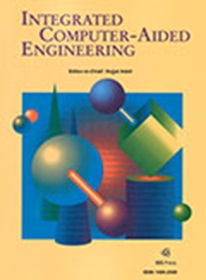用机器学习检测稳定抓点的三步模型
IF 5.3
2区 计算机科学
Q1 COMPUTER SCIENCE, ARTIFICIAL INTELLIGENCE
引用次数: 4
摘要
机器人在动态环境中的抓取仍然是自动化任务中的主要挑战之一。深度学习方法和计算能力的进步表明,机器人抓取问题可以通过使用大量的训练数据和深度网络来解决。尽管取得了这些巨大的成就,但在现实场景中的接受和使用仍然有限。这主要是由于训练数据的收集是昂贵的,并且训练后的网络是一个黑匣子。虽然训练数据的收集有时可以通过在模拟中进行方便,但训练后的网络仍然是一个黑盒子。在这项研究中,提出了一个三步模型,利用仿真方法和深度神经网络的优势来识别和评估抓手点。此外,它甚至为抓握失败提供了解释。第一步是找到所有的抓手点,在那里抓手可以降低到桌子上,而不会与物体碰撞。第二步是从第一步开始确定抓手点和抓手参数,确定抓手关闭时物体的运动方式。最后,在第三步中,对于第二步中的所有抓取点,预测物体在提升过程中是否滑出抓取器。通过这种简化,有可能理解每个要点为什么是稳定的,同样重要的是,为什么其他要点不稳定或不可行的。评估三个步骤中每个步骤中使用的所有模型以及最终的总体模型。将总体模型预测的抓地点与力闭合算法解析确定的抓地点进行比较,验证预测抓地点的稳定性。本文章由计算机程序翻译,如有差异,请以英文原文为准。
A three-step model for the detection of stable grasp points with machine learning
Robotic grasping in dynamic environments is still one of the main challenges in automation tasks. Advances in deep learning methods and computational power suggest that the problem of robotic grasping can be solved by using a huge amount of training data and deep networks. Despite these huge accomplishments, the acceptance and usage in real-world scenarios is still limited. This is mainly due to the fact that the collection of the training data is expensive, and that the trained network is a black box. While the collection of the training data can sometimes be facilitated by carrying it out in simulation, the trained networks, however, remain a black box. In this study, a three-step model is presented that profits both from the advantages of using a simulation approach and deep neural networks to identify and evaluate grasp points. In addition, it even offers an explanation for failed grasp attempts. The first step is to find all grasp points where the gripper can be lowered onto the table without colliding with the object. The second step is to determine, for the grasp points and gripper parameters from the first step, how the object moves while the gripper is closed. Finally, in the third step, for all grasp points from the second step, it is predicted whether the object slips out of the gripper during lifting. By this simplification, it is possible to understand for each grasp point why it is stable and – just as important – why others are unstable or not feasible. All of the models employed in each of the three steps and the resulting Overall Model are evaluated. The predicted grasp points from the Overall Model are compared to the grasp points determined analytically by a force-closure algorithm, to validate the stability of the predicted grasps.
求助全文
通过发布文献求助,成功后即可免费获取论文全文。
去求助
来源期刊

Integrated Computer-Aided Engineering
工程技术-工程:综合
CiteScore
9.90
自引率
21.50%
发文量
21
审稿时长
>12 weeks
期刊介绍:
Integrated Computer-Aided Engineering (ICAE) was founded in 1993. "Based on the premise that interdisciplinary thinking and synergistic collaboration of disciplines can solve complex problems, open new frontiers, and lead to true innovations and breakthroughs, the cornerstone of industrial competitiveness and advancement of the society" as noted in the inaugural issue of the journal.
The focus of ICAE is the integration of leading edge and emerging computer and information technologies for innovative solution of engineering problems. The journal fosters interdisciplinary research and presents a unique forum for innovative computer-aided engineering. It also publishes novel industrial applications of CAE, thus helping to bring new computational paradigms from research labs and classrooms to reality. Areas covered by the journal include (but are not limited to) artificial intelligence, advanced signal processing, biologically inspired computing, cognitive modeling, concurrent engineering, database management, distributed computing, evolutionary computing, fuzzy logic, genetic algorithms, geometric modeling, intelligent and adaptive systems, internet-based technologies, knowledge discovery and engineering, machine learning, mechatronics, mobile computing, multimedia technologies, networking, neural network computing, object-oriented systems, optimization and search, parallel processing, robotics virtual reality, and visualization techniques.
 求助内容:
求助内容: 应助结果提醒方式:
应助结果提醒方式:


